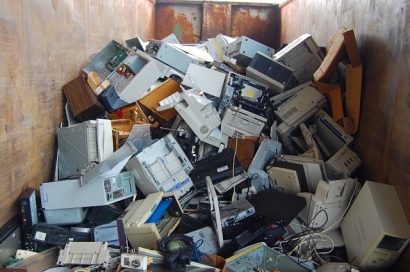
Waste from electronic and energy items has surged in growth as the consumer electronics industry has exploded over the last several decades. However, many people are unaware of the true impact of e-waste worldwide. The United Nations Environment Programme estimates that upwards of 50 million metric tons of e-waste is produced each year. This largely ends up going to landfills or scrap yards, where people meticulously inspect each piece for gold, copper and other metals commonly used in electronic components.
While the metals found in e-waste can be worth billions of dollars, the problem is that e-waste can expose people to highly toxic chemicals and heavy metals. These toxins can result in countless health hazards, from developmental damage in children to lung problems from breathing in chemicals. Even those not regularly in proximity to e-waste can be affected by environmental contamination.
Exposure to toxic chemicals and heavy metals is arguably the most damaging effect e-waste has on human health. The people who pick through e-waste for a living are the most at risk of detrimental exposure to things like lead and airborne pollutants. The surrounding communities near e-waste landfills are often exposed to incredibly high levels of toxins through food and water supplies, as well. Sadly, many of those directly affected in this manner are children.
The World Health Organization has conducted thorough studies on the issue, which is estimated to impact millions of children around the globe. These studies have found that e-waste toxins can increase stillborn and premature births. Additionally, children heavily exposed to e-waste were found to have higher rates of neurological disorders and behavioral issues and diminished cognitive and language abilities. Major medical conditions were connected to e-waste toxins, as well, including respiratory harm, cardiovascular disease and even DNA damage.
Only 20% of e-waste is recycled each year worldwide. This means about 80% of the millions of tons of e-waste produced each year is incinerated or sent to landfills. This contributes significantly to global greenhouse gas emissions.
When electronics are burned, they release multiple harmful chemicals into the air. These are often the result of flame retardants used in many electronics. This can pose serious health risks to those working at waste incineration facilities and the surrounding communities. These chemicals also contribute to carbon dioxide emissions, which are the main contributors to global warming.
The manufacturing of electronics is not a carbon-neutral process, either. Recycling more electronic components could lead to compounded benefits over time, since less e-waste would end up thrown away and fewer new electronic components would need to be produced. The growing transition to renewable energy is helping to reduce these emissions, as well.
In addition to harming air quality, e-waste toxins can easily seep into the soil and waterways surrounding recycling and landfill facilities. This is harmful to the environment and can also lead to health issues over time as people unknowingly drink contaminated water or eat meat or produce exposed to toxins. Experts have pointed out that these effects reach the whole world, not just developing nations where e-waste-related risks are greatest.
Properly handling e-waste of all varieties can improve quality of life, even increasing profits for businesses. For example, solar panels are a key component of renewable energy, but they can also be recycled to make new ones once they grow old or stop working.
In fact, researchers have even developed a way to convert electronic waste into clean hydrogen fuel. This means recycling e-waste can become a source of income through either conversion into power or reuse in new electronics and renewable energy components. Increasing these recycling methods would create jobs for thousands of people and provide clean energy to countless communities.
Properly handling electronic and energy waste is a global imperative. Whether we see it or not, e-waste is impacting every community worldwide, through air, water, soil, food and pollution. Electronics and energy devices can be recycled and reused to create something new and power a healthier world.

